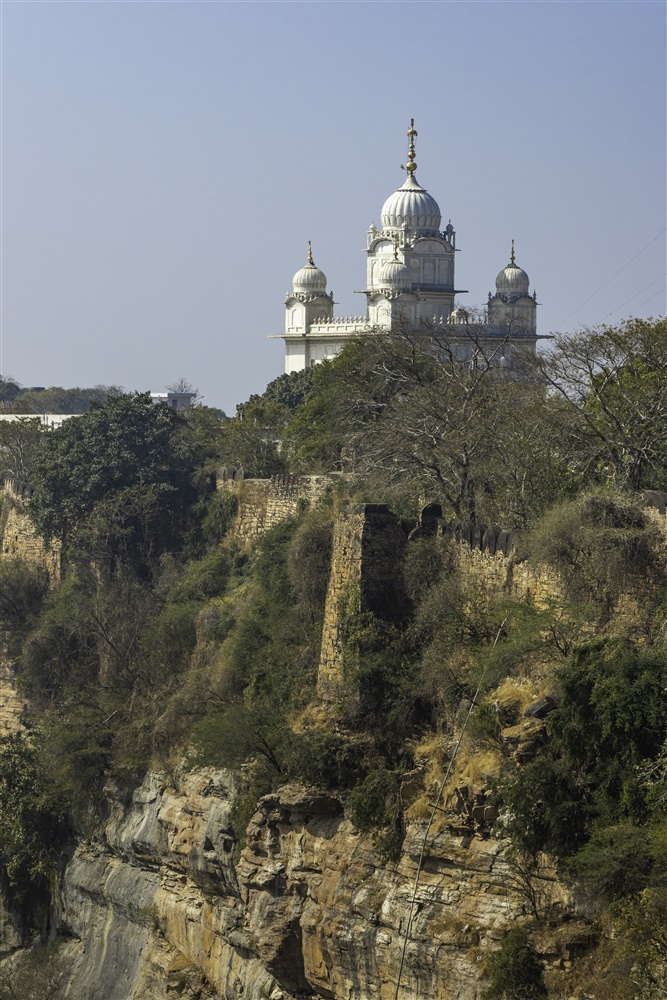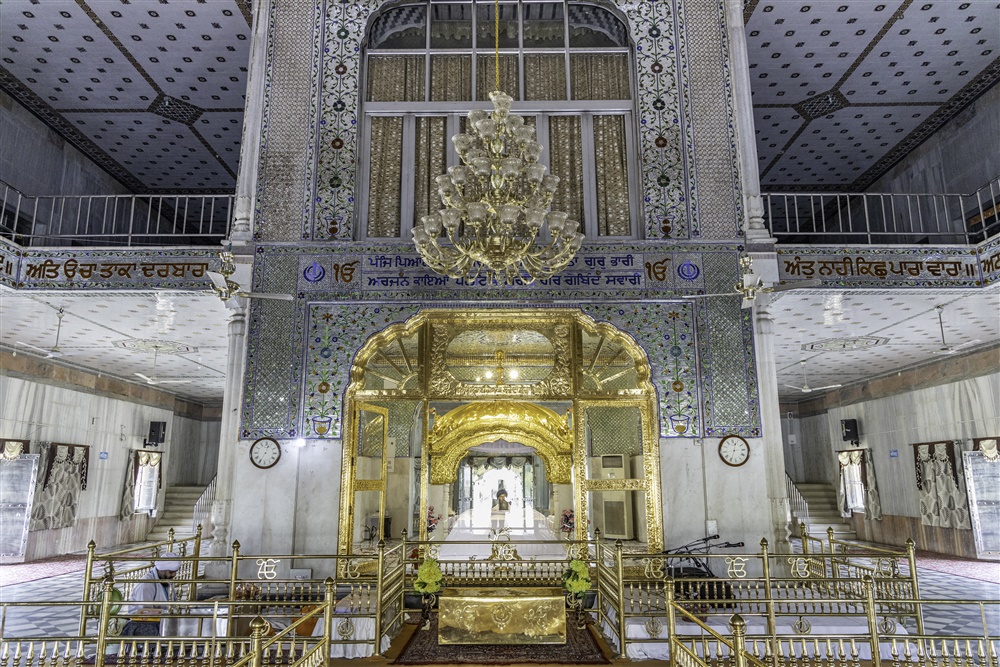
Dominating the landscape on top of Gwalior hill, Gurdwara Data Bandi Chor Sahib is a Sikh monument associated with the imprisonment and subsequent release of Guru Hargobind Sahib.
Guru Hargobind was born on 19th June 1595 near Amritsar and became Guru at the young age of eleven after the execution of this father, Guru Arjan, by the Mughal emperor Jahangir. He is revered as the sixth Nanak, the sixth of ten Gurus of the Sikh religion.


His tenure as a Guru was the longest of all nine Gurus, lasting almost 38 years. During that time he introduced militarization in order to protect the Sikhism community against the Mughals, most likely as a response to his father’s execution.

In response to his desire for Sikhs to arm and fight the Mughals, Jahangir imprisoned Guru Hargobind in 1609 when he was just 14 years old in Gwalior Fort. Not wanting to recognise the threat Guru Hargobind was to Mughals, Jahangir instead claimed it was due to an unpaid debt associated with Guru Arjan, Hargobind’s father.

It is not clear how long Guru Hargobind was imprisoned, in some records it was for 2 years, in other sources up to 12 years. Nor is it clear exactly why he was released, many scholars believe it was because Jahangir subsequently felt more secure in his rule and regarded Hargobind as relatively harmless.

There is a legend surrounding Guru Hargobind’s release. The story goes that along with Hargobind there were 52 Rajas also imprisoned in Gwalior Fort for opposing the Mughal empire.
On hearing of Guru Hargobind’s imminent release, the Rajas were dismayed as they were losing a spiritual mentor. Guru Hargobind requested Jehangir to let the Rajas be freed along with him. Jahangir accepted his request, but ordered the release of only as many as could hold onto the hem of his cloak when he walked out. So Guru Hargobind got an especially large cloak made and wore it the day of his release. As Guru Hargobind left the fort, the other 52 captive rajas held the hem of this cloak and thus were freed along with him.


This act earned Guru Hargobind the title Data Bandi Chor (the munificent liberator). The word “Bandi” means “imprisoned”, “Chor” means “release”.
Relations with the Mughals were subsequently luke warm, but deteriorated significantly during the reign of the less tolerant Shah Jahan. Guru Hargobind’s army fought battles with the Mughal armies at Amritsar, Kartarpur and elsewhere. He famously defeated the Mughal troops at the Battle of Amritsar in 1634.
Guru Hargobind died in 1644 at Kiratpur Sahib, a town situated on the banks of river Sutlej. He was cremated on the banks of river Sutlej, where now stands Gurdwara Patalpuri.

A small shrine to Guru Hargobind was built within the walls of Gwalior fort which was looked after by Muslim priests until it was acquired after independence in 1947. The area around the shrine was extended in the 19702s and 1980s to over six acres, and a new much larger shrine and subsidiary buildings were built.

Gurdwara Data Bandi Chorh Sahib is located very close to Sas Bahu and Teli Ka Mandir and it is free to visit what is a very peaceful place.
Please ‘Like’ or add a comment if you enjoyed this blog post. If you’d like to be notified of any new content, just sign up by clicking the ‘Follow’ button. If you have enjoyed this or any other of my posts, please consider buying me a coffee. There’s a facility to do so on the righthand side of this website for desktop users, and just above the comment section for mobile users. Thank you !
If you’re interested in using any of my photography or articles please get in touch. I’m also available for any freelance work worldwide, my duffel bag is always packed ready to go…
KevinStandage1@gmail.com
kevinstandagephotography.wordpress.com
Categories: Gurdwara Data Bandi Chor Sahib, Gwalior, Gwalior Fort, India, Madhya Pradesh





Nonsense developer 😡
You will have to bear the wrath of God. I think you have intentionally written Daata Bandi Chor to the Bandi Chhod.
LikeLike
Sir, I do not understand why you are upset. Is this not the name of place ? I did not mean to offend in any way, please explain.
https://www.google.com/maps/place/Gurudwara+Data+Bandi+Chhor+Sahib/@26.2202653,78.16727,15z/data=!4m5!3m4!1s0x0:0xbd5eb3fd0bae5572!8m2!3d26.2202653!4d78.16727
LikeLike
Mr Standage,
Perhaps the gentleman is offended due to a mis-understanding.
It is likely that the word being referred to is the one in the title, as also in the very first sentence, and in the sentence below the seventh and eight photographs. (the title says “– — — Chor –“, the first sentence says “Dominating — hill, —- Chor Sahib”, the sentence below the seventh – eighth photograph says “This act earned Guru Hargobind ——- Chor (the munificent liberator). The word “Bandi ” ——, “Chor” means “release”.
The word “chor” in Hindi means ‘thief’. So, in such cases, it is written as ‘chhor’, which does not cause offence. Or ‘chorh’, which is also OK. Spelling it with a ‘d’ (which is also how it is pronounced, and which is suggested by the gentleman above) may also cause controversy, as it may be mistaken for another insulting word. This happens because it is difficult to exactly transliterate Hindi words into English, and (as far as I know) there is no universally accepted standard for doing so.
The very last sentence ‘says “Gurdwara Data Bandi Chorh Sahib —“, which is OK (ie chorh is also OK). .
The content, and the overall tone and tenor of all your articles (or blog posts), as indeed this article, make it clear that no offence is intended. Quite the opposite, in fact. You have always displayed restraint to avoid hurting other peoples’ sensitivities, to an extent that is not usual.
It is possible (or, likely) that Mr Harpal Singh Singh has not read through the post, and hence has mis-interpreted the word.
One hopes that you overlook such comments as the one above dated 29 June 22, time 12:38 AM. Like I said, if the person had read through the text, and/ or if he had read through your posts over the years, he would (most probably) have not have taken offence.
On a separate note, I thank you for the wonderful posts (text plus photographs) on this website. I (and, I imagine, many many others) are grateful to you for taking the trouble to visit and write about these sites. There are not many people who do so. Your blog is an oasis in a desert with few such oases.
Once again, I think you for your posts, test and photographs. One is grateful to you for the efforts you have put in over the years, using your own resources and time. Many many thanks.
Regards, and wish you all the best.
Sekhar
LikeLiked by 1 person
Sir – thank you for your comprehensive comment, I now understand what was driving that comment from Mr Harpal Singh Singh, which I confess did leave me very confused and a little bit concerned.
I will attempt to edit this blog post soon to at least put right my clumsy mistake.
Thank you so much for your kind words, and for taking so much time to fully explain the situation.
Kevin.
LikeLike